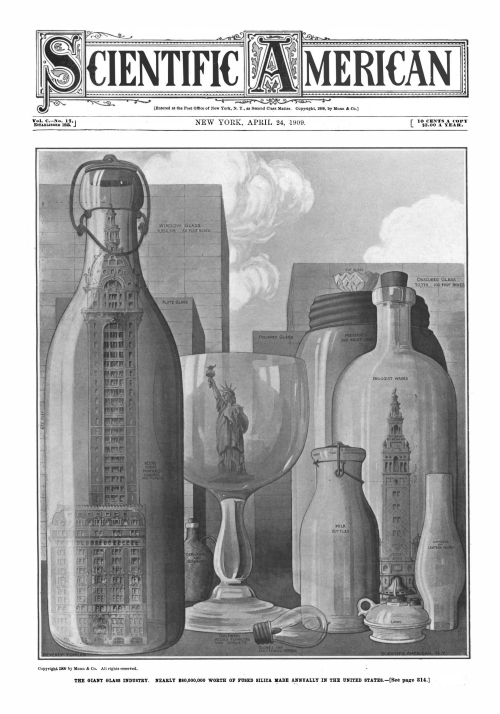JF Ptak Science Books Quick Post
This I believe is the eighth installment of a series of posts on articles using infographics comparing objects to buildings and skylines. Ships are often seen this way--comparing the newest/largest to some well-known building in, usually, the NYC skyline. There are variations: for example, nail and salt production are depicted as enormous single objects showing that if you combined all nails made in the U.S. into one 100' diameter nail, it would be as big as the Singer Building, or some such. The current example is the first I've found where the gigantic production item encloses the building against which it is being compared, showing the size of famous structures relative to all of the glass of a particular sort had they been manufactured and produced as one single unit. This makes for a striking non-sequitur object, and gets the intended point across of how large the various glass manufacturing industries are
The short article starts out little unevenly and stays there:
"If we consider the minor factors of civilization, glass should certainly be accorded a very high place, as it enters into many of the daily affairs of life. It is one of the oldest industries in the world. Pliny, states that certain Phoenician merchants were preparing a meal on the seashore, and set their cooking vessel on a mass of the sand and alkali, which, when subjected to the fire, resulted in vitrification. In all the ages glass manufacture was considered of prime importance, and was often regulated by government edicts."--Scientific American, April 24, 1909, p. 314.
And then the short explanation of the imagery:
"We have chosen the graphical method of presentation, and have translated the quantities into mammoth jars, boxes,
bottles, lamps, and chimneys. The Singer Building looks well protected from the elements in the immense bottle.
The Statue of Liberty holds her torch aloft in the goblet, which symbolizes the tableware, tumblers, etc., without
touching the brim. The use of oil lamps in the United States is decreasing, due to the wider use of gas and electricity,
still the lamp shown represents more than a million dollars' worth. In our comparison building-glass looms up very
large, the magnitude of the industry being shown by the figures. Many of the most important inventions connected
with glass are due to Americans, and the industry is a typical American line."--Scientific American, April 24, 1909,
p. 314.



Comments